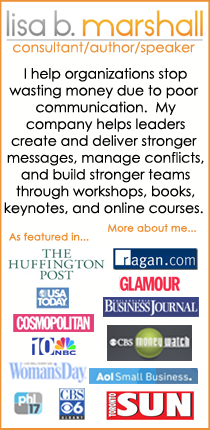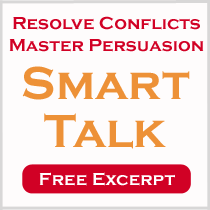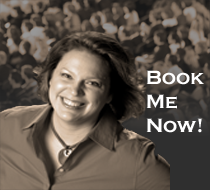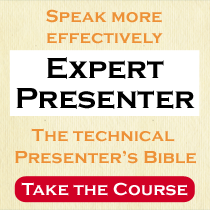Uncategorized
//
Lisa B. Marshall
//
//
Do you get nervous before or during a presentation? In this audio broadcast, I share several practical solutions to this very common problem. To learn how to appear relaxed and under control listen to an excerpt from a live program delivered at Memorial Sloan Kettering Cancer Center
I love to hear from her listeners.
Call the listener line with your questions or comments: 206-984-4278 .
Read more »
Uncategorized
//
Lisa B. Marshall
//
//
In science, it is critical that your slides communicate your work in a clear, efficient manner. Don’t make the mistake that most scientist make…”the figure dump”.
Learn how to create great slides in this audio broadcast that was recorded live in NYC.
Your Challenge:
Submit a few of your slides here for review! See if you can apply the ideas for effective display of quantitative information.
Read more »
Uncategorized
//
Lisa B. Marshall
//
//
Learn how to improve your scientific posters by reviewing samples. You can see first hand what works and what doesn’t.
I have viewed hundreds, if not thousands of posters, and this first example is pretty good. Well, honestly, even this one could use some improvement, but it still is among the best.
Take a look for yourself…
http://www.ncsu.edu/project/posters/NewSite/examples/Flounder.
Read more »
Uncategorized
//
Lisa B. Marshall
//
//
Scientific and technical poster presentations require skills in two key areas: artistic design along with technical writing/editing. Different from papers, the critical first impression from a poster is created through the effectiveness of the visual design. For scientists, it is perhaps the area you are least familiar with and warrants some of your time for review.
Read more »
Uncategorized
//
Lisa B. Marshall
//
//
How to I make an EFFECTIVE poster?
No point in “re-inventing the wheel” when there are a number of great resources available that guide you through the process of developing an effective poster. I suggest you look at ALL of these links below if you have the time, because each includes slightly different nuances.
Read more »
Uncategorized
//
Lisa B. Marshall
//
//
Learn how to use transitions to make connections.
Click here to listen via the Art of Speaking Science Channel
Do your presentations smoothly flow from beginning to end? Do you always clearly link one idea to the next? If not, help is on the way. In this Lisa Live episode from Art of Speaking Science, you’ll learn how to successfully incorporate effective transitions into presentations.
Read more »
Uncategorized
//
Lisa B. Marshall
//
//
I am not a funny person. But I have worked very hard to add humor into my presentations. In this entry you’ll learn 3 tips for incorporating humor into presentations.
Read more »
Uncategorized
//
Lisa B. Marshall
//
//
Here’s a presentation from particle physicist Janet Conrad at Columbia University titled “How to Write and Give a Good Scientific Talk”…
While I disagree with her on a few minor points, I think she does a good job at covering the basics and she also has some interesting, creative examples…
Read more »
Uncategorized
//
Lisa B. Marshall
//
//
“And now I am going to talk about …”
This is probably the most common “transition” that I hear, especially when a scientific speaker moves from one slide to the next. The problem with this is approach is that it really doesn’t transition at all.
Specifically, it fails to make a connection, which is the main purpose of the transition.
Read more »
Uncategorized
//
Lisa B. Marshall
//
//
I’ll never forget the day when Jane, my boss at that time, called me into her corner office for one of her famous “professional development discussions”. Perhaps because I was a young manager Jane felt compelled to offer me extra career advice and guidance whenever she felt I had gotten off-track. Usually it was good advice, but this day was different.
Read more »








